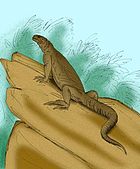Genus of lizards
Socognathus is a genus of prehistoric chamopsiid polyglyphanodontian lizards[1] containing species that lived from the Middle Campanian stage to the late Maastrichtian. Several specimens of the type species, Socognathus unicuspis, have been found in Alberta, Canada.[2][3] A second species, Socognathus brachyodon is known from the late Maastrichtian Lance Formation; its fossils have been found in Wyoming, United States.[1][4]
References
- ^ a b Nicholas R. Longrich; Bhart-Anjan S. Bhullar & Jacques A. Gauthier (2012). "Mass extinction of lizards and snakes at the Cretaceous–Paleogene boundary". Proceedings of the National Academy of Sciences of the United States of America. 109 (52): 21396–21401. Bibcode:2012PNAS..10921396L. doi:10.1073/pnas.1211526110. PMC 3535637. PMID 23236177.
- ^ Peng, J.; A. P. Russell & D. B. Brinkman (2001). "Vertebrate microsite assemblages (exclusive of mammals) from the Foremost and Oldman Formations of the Judith River Group (Campanian) of southeastern Alberta: an illustrated guide". Provincial Museum of Alberta, Natural History Occasional Paper. 25: 1–546.
- ^ Wood, D. (Jul 2010). "New species named: Kleskunsaurus grandeprairiensis". Daily Herald-Tribune. Retrieved 27 Oct 2010.
- ^ Nicholas R. Longrich; Bhart-Anjan S. Bhullar & Jacques A. Gauthier (2013). "Correction for "Mass extinction of lizards and snakes at the Cretaceous–Paleogene boundary," by Nicholas R. Longrich, Bhart-Anjan S. Bhullar, and Jacques A. Gauthier, which appeared in issue 52, December 26, 2012, of Proc Natl Acad Sci USA (109:21396–21401; first published December 10, 2012; 10.1073/pnas.1211526110)". Proceedings of the National Academy of Sciences of the United States of America. 110 (16): 6608. doi:10.1073/pnas.1303907110. PMC 3631639.




